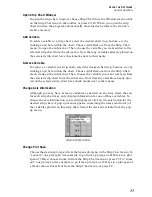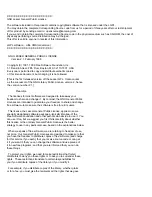
91
5
T
E C H N I C A L
R
E F E R E N C E
This chapter covers several technical topics which may help you better under-
stand and use the software.
A
R C H I V E
M
E M O R Y
V S
. D
A T A B A S E
There are two places where the WeatherLink stores weather data: the archive
memory and the database.
Archive Memory
The archive memory is the weather information storage area in the WeatherLink
itself. At each archive interval the WeatherLink stores one record to archive mem-
ory. The WeatherLink has room in the archive memory for approximately 1 day of
weather data for each minute in the archive interval. For example, if you use the 1
minute archive interval, the WeatherLink may store approximately 1 day of data.
If you use the 30 minute archive interval, the WeatherLink may store approxi-
mately 30 days of data. If you use the 2 hour archive interval (120 minutes), the
WeatherLink may store approximately 120 days of data.
Note:
To aid you in determining when you need to download, the software shows you what percent
of archive memory is full whenever you download data.
When the archive memory “fills” the WeatherLink overwrites old data each time
it stores a new record. Because of this, it is best to select the longest archive inter-
val which suits your purpose. In addition, make sure to download data before
your archive memory fills or you will have gaps in your database.
Database
The database is the permanent record of data stored on disk. When you down-
load, the software transfers all information in the archive memory to the com-
puter and writes the information into the appropriate database files. If you do not
clear the archive memory when downloading data (see “Station Config” on
page 19), the software will incorporate any data that post-dates the existing data-
base. The software will not overwrite existing data. This means that if, for exam-
ple, your station loses power and, upon power up, begins logging data at the
default date January 1,
this data will not make it into an existing database
as it will
precede the most recent date.
As the software writes the data to database files, it calculates the average wind
chill and average dew point. The temperature/humidity index, Equilibrium
Moisture Content, and air density, on the other hand, are calculated by the soft-
ware as needed.
The software stores data to disk in monthly blocks, each of which is a separate
data file in the weather station's directory. The name of the data file indicates the
year and the month of the data and has a three character file extension which indi-
cates the station from which that data came.
















































